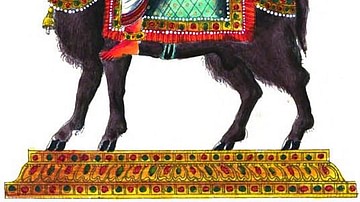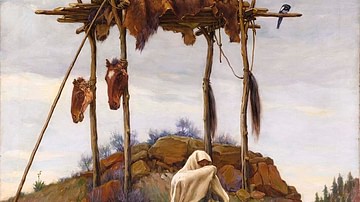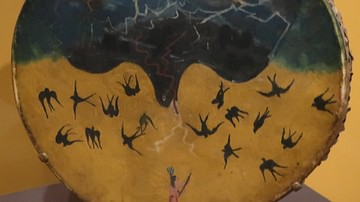
Yama is the Hindu god of death, king of ancestors, and final judge on the destination of souls. He is also known as the 'Restrainer', Pretaraja or 'King of Ghosts', Dharmaraja or 'King of Justice', and as Daksinasapati is considered the regent of the South Quarter. Yama may also be referred to simply as 'Death' – Antaka, Kala or Mrtyu. Due to his responsibility for good decision-making based on records of a person's deeds, the god is particularly associated with the rule of law. Yama is also present in Iranian mythology, traditional Chinese and Japanese mythology, and elements of Buddhism.
Yama's Family Relations
Yama is the son of the sun god Vivasvat (or Visvavasu in other versions) and his mother is Saranyu-Samjna (Conscience). He is the brother of Manu or Vaivasvata and he also has a twin sister, Yami (or Yamuna). Yama and Yami are, in some myths, the first humans and creators of the human race but in other versions Yama is the first human to die and so the first to pass into the next world. Yama is considered the father of Yudhisthira, one of the five Pandu princes. His wives are Hemamala, Vijaya, and Susila.
Yama as Judge of Souls
Unlike the god of the dead or the underworld in other cultures, Yama is not always described as a punisher of the wicked. The god is feared by some, though, especially because of his two great hounds. These fearsome creatures have four eyes and they guard the path which the dead must take to reach Yama. The dogs are sometimes sent to the world of the living in order to beckon souls to Yama. In other versions, a bird performs this duty, calling the dead to the god's city of Yamapura, deep in the murky underworld. In yet another version, Agni (the Hindu god of fire and son of Yama and Yami) leads the dead to Yama.
When souls arrive in Yama's Kalici palace, they are first met by Yama's porter Vaidhyata and then two attendants Kalapurusa and Chanda (or Mahachanda) usher them to an audience with the great god. First, their worldly deeds are read out by Yama's scribe Citragupta, who consults a massive register, the Agrasandhani. Based on this evidence Yama sits on his throne of judgement (Vicarabhu) and considers the three options he has at his disposal. The first and best is to be given immortality by drinking soma and sent to live forevermore with the wise and saintly pitrs or Manes, to whom Yama is king. Here the good will enjoy eternal happiness and shine as stars in the celestial heavens. The second option is to be sent back into the world and be reborn in order to, as it were, have another go at leading a good life, although not necessarily as a human. The third and worst option is to be sent down into the 21 levels of hell; the lower the level, the worse the punishment.
Yama's Curse
Yama appears in an unflattering episode in the Puranas. Attempting to kick his mother Samjna (or in another version Chaya, one of his father's maids), Yama succeeded only in receiving a curse from his would-be victim. He was condemned to have a terribly wounded leg which never healed and became infested with maggots. Fortunately for Yama, his father gave him a cock which ate all the vermin in his leg and eventually he recovered, even if his permanently damaged leg thereafter gained him the name of Sirnapada or 'shrivelled foot'.
Yama in Art
In Hindu art, Yama is often portrayed with green or blue skin and wearing red robes. His vehicle is a buffalo (or elephant) and he often carries a mace or rod —which was made from a part of the sun— and a noose, the latter symbolic of his role as a catcher of souls. Indeed, he is sometimes known as Pasi, 'the noose-carrier'.
In Tibet, where Yama is known as Gsin-rje, the god is often represented with a demonic face and viciously stamping on somebody. Yama appears in similar pose on reliefs at Angkor Wat, Cambodia. Finally, he is a familiar statue figure in many Chinese temples where he is known as Yen-lo wang.





